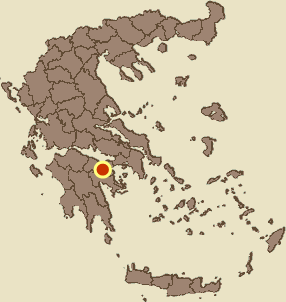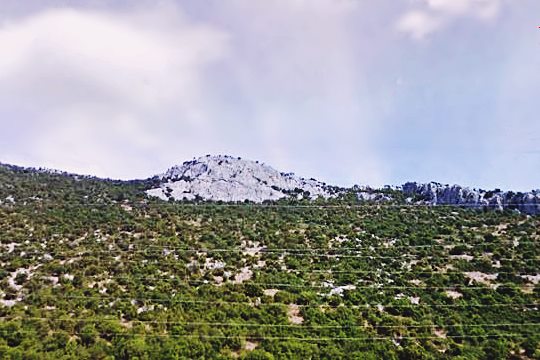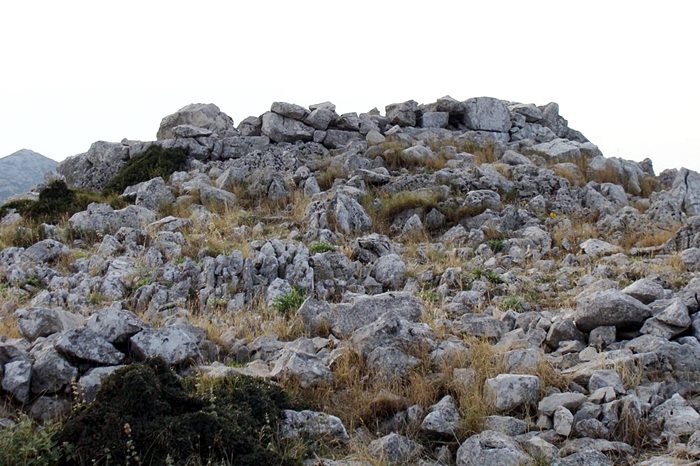Klenia, Corinth, Corinthia,Peloponnese
Castle of Ampiditsa
| Location: |
| On a rocky peak of mount Ampiditsa above the village Klenia, south of Corinth |
| Region > Prefecture: |  |
| Peloponnese Corinthia | |
| Municipality > Town: | |
| City of Corinth • Klenia | |
| Altitude: | |
|
Elevation ≈ 720 m (Relative Height≈280 m) |
| Time of Construction | Origin | |
| Mid-Byzantine period | BYZANTINE |
|
| Castle Type | Condition | |
| Dry-Stone Fortification |
In Ruins
|
Remains of an ancient tower and of a medieval fort on a steep rock (south peak of mount Ampiditsa) at the northern end of the passage of Kleisoura of Agionori.
Location & Strategic Scope
The fort is situated about 500 m west of the deserted Monastery of Faneromeni , at an altitude of 720m. It lies at the southernmost tip of the mountain of Ampiditsa, at the north entrance to the passage of Kleisoura of Agionori. It surveyed not only the Kontoporeia, the shortest route linking Corinth with the Argolid plain, running through the mountain pass of Kleisoura, but also the secondary road that led from Corinth to Piada and Epidaurus, through the valley where the Faneromeni Monastery was built.
The fort has visual contact with the castle at Agionori which protected the southern entrance to the pass. Close to the castle of Ampiditsa to the east (3km) there are the ruins of another castle, the castle of Alataria.
History
The castle is not mentioned in Frankish documents. It was an ancient fort that was also in use by the Byzantines in the Middle Ages. The medieval fortification must have been added sometime between the 9th and the 12th century AD.
Apparently the fort was not used by the Franks nor later by the Ottomans.
The cylindrical tower at the center is an ancient construction (from the classical period, probably) while the external wall is medieval.
Structure, Fortification & Buildings
The fortress consists of a circular tower protected by two zones of fortifications. The south and southwest sides of the castle are not walled, due to steep terrain and the safety it bestows. The interior precinct has an irregular shape and surrounds the tower on all sides, except the one towards Kleisoura. The wall survives to but a small extent; it has a thickness of 1.20m.
The outer enclosure is almost triangular and completely in ruins. Remains of a few buildings have been located, mainly in the southern part between exterior and interior enclosures.
The central tower is 6.30 m in diameter, preserved to a height of about 0.80-1m and is made in the dry-stone technique. Its walls have a thickness of 2m and include well-shaped stones.
| First entry in Kastrologos: | January 2018 |
Sources
- Pictures from Panoramio, user Farsarakis Giannis
- Κορδώσης, Μ.Σ., Συμβολή στην ιστορία και τοπογραφία της περιοχής Κορίνθου στους μέσους χρόνους, διδ. διατριβή, Αθήνα 1981, 141-172.
- Κορδώσης, Μ.Σ., Αρχαία και πρωτοβυζαντινή Τενέα, Ιωάννινα 1999 [= ανάτυπο από Δωδώνη, τ. ΚΣτ’, 1 (1997)], 522
- Πέππας, Ι. Ε., Μεσαιωνικές σελίδες της Αργολίδος, Αρκαδίας, Κορινθίας, Αττικής, Αθήναι 1990, 229.
- Website ecastles - Ampiditsa, castle
- pictures by Aris Gotsis
- Δημήτριος Περσέας Λουκίσσας, ΑΡΓΟΛΙΔΑΣ, ΚΟΡΙΝΘΙΑΣ ΠΕΡΙΗΓΗΣΙΣ, τόμος Α’, Ανοιχτή Πόλη, Αθήνα, 2021, σ.80,81
|
|
| Access |
|---|
| Entrance: |
| Free access |









